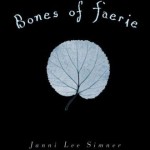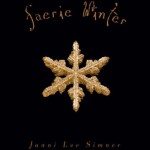 Very little attention has been paid to the social justice issues found in Janni Lee Simner’s book Bones of Faerie. When it opens, the main character Liza is an emotional wreck, seeking answers to why her baby sister had to be thrown outside to die just because she had shown evidence that she had “magic.” A war between humans and fairies had thrown the human world as we know it back into a time before cars and highways and telecommunications. The human relationship to the earth is fraught with new dangers—the war had left plants with magical powers, making them mortally dangerous to humans. When Liza’s mother disappears, and Liza realizes that all the children of the village are manifesting signs of magic, she goes in search of her mother. She soon learns that the war had been far more complicated than the story she’d been told all her life, that fairies aren’t all “evil,” that they alone have the power that can precipitate healing, and that it will be necessary to embrace the “magic” that her village was so afraid of in order for humanity to move forward. Simner explores the social destructiveness of war and us v. them social dynamics, as well as the literal destructiveness of a nuclear holocaust in the first book of the series and continues the saga (and the themes) in the second book, Faerie Winter.
Very little attention has been paid to the social justice issues found in Janni Lee Simner’s book Bones of Faerie. When it opens, the main character Liza is an emotional wreck, seeking answers to why her baby sister had to be thrown outside to die just because she had shown evidence that she had “magic.” A war between humans and fairies had thrown the human world as we know it back into a time before cars and highways and telecommunications. The human relationship to the earth is fraught with new dangers—the war had left plants with magical powers, making them mortally dangerous to humans. When Liza’s mother disappears, and Liza realizes that all the children of the village are manifesting signs of magic, she goes in search of her mother. She soon learns that the war had been far more complicated than the story she’d been told all her life, that fairies aren’t all “evil,” that they alone have the power that can precipitate healing, and that it will be necessary to embrace the “magic” that her village was so afraid of in order for humanity to move forward. Simner explores the social destructiveness of war and us v. them social dynamics, as well as the literal destructiveness of a nuclear holocaust in the first book of the series and continues the saga (and the themes) in the second book, Faerie Winter.
I was so intrigued by the books and their themes that I asked Janni to answer some questions. Here are her thoughts on war, us vs. them, the environment, and writing.
1) You explore some important themes related to war, the environment, nuclear holocaust, and us vs. them social dynamics in your fantasy novel, Bones of Faerie, and its sequel, Faerie Winter. Can you talk about the way you explored these issues in your novels? Can you discuss some of the questions you had or that you wanted to explore that propelled your story as it relates to these themes?
I wrote the opening scene of Bones of Faerie 10 years before I wrote the rest, back in the mid-90s. I knew from the first page that there’d been a devastating war between the human and Faerie realms and that faerie magic had destroyed our world, so from the start the books were about the effects of war and conflict and violence, though it wasn’t until I started writing the rest of the story that I really began thinking about what that meant.
Once I did start writing more seriously, I think my late-cold-war childhood began informing the story. I’d grown up in an era when the idea that wars were winnable was pretty alien, because any war meant nuclear war which meant that we all suffered. I realized pretty early on that a war on the scale I was imagining in Bones of Faerie couldn’t only have destroyed our world; it would have to have destroyed Faerie as well, because if the Faerie folk had deadly magic, humans had deadly weapons, too, just as we do now. The war I was writing about wasn’t a war with winners or loser eithers, but with survivors on all sides trying to make sense of all that had happened and figure out how to live it.
Bones of Faerie focuses closely on Liza, who was born after the War, didn’t fight in it, and did nothing to cause it, yet has to live with its consequences anyway, because the consequences of conflicts do echo on long past when the fighting is through. In the sequel to Bones of Faerie, Faerie Winter, I found myself also writing a faerie adolescent, Elin. Elin is in many ways Liza’s counterpart, yet because faeries live longer than humans, she did live through the war and remembers it vividly.
Once Elin stepped on stage, the us vs. them issues, which had always been part of the story, came into sharper relief for me, because suddenly we had two girls, each keenly aware of her own losses, and each seeing, not inaccurately, the other as part of their cause. One of the things I’ve come to understand, in both reading about conflict and watching how we cope with it today is that we all see our own losses first, and tell our stories from them, and only with work come to understand the losses of others. It’s something Liza and Elin both struggle with, and that Elin especially will continue to struggle with into the third (and final, from Liza’s point of view at least) Faerie book, Faerie After.
 As for the books’ environmental issues … I started writing Bones of Faerie while living in the Midwest, but finished it when living in the Southwestern desert. Living in an edge environment–a place where if conditions were just a little bit harsher life might not exist at all–made me much more aware of the land around me and our dependence on it, and that influenced the books, with their deadly trees and other natural dangers, too.
As for the books’ environmental issues … I started writing Bones of Faerie while living in the Midwest, but finished it when living in the Southwestern desert. Living in an edge environment–a place where if conditions were just a little bit harsher life might not exist at all–made me much more aware of the land around me and our dependence on it, and that influenced the books, with their deadly trees and other natural dangers, too.
2) Though you don’t offer “answers” or “solutions” to these issues that your novel raises, you do offer a picture of the ways these issues complicate human relationships with each other and with the earth. Can you talk about resisting the impulse to provide a “lesson” or to provide simple, perhaps even black and white ideas about these problems? How have readers responded to the nuanced and complex way you’ve presented these problems?
When I started writing the Faerie books, I think a part of me wanted straightforward answers. I wanted my characters to eventually find a way of saying, “And now, with all we’ve learned, we’re going to see to it for certain that tragedies like the war never happen again”–even though we’ve never yet managed that in our own world.
But my characters, who so often understand my stories better than I do, wouldn’t let me get away with that. Liza especially is very practical, and after all she’d suffered because of the war, she was far less willing to believe unconditionally that nothing would ever go wrong again, or that people would always act better the next time around. Liza, like many of the characters in the books, came to a place where she was willing to try to do all she could–even at great risk–in order to heal the damage that had been done and to keep it from happening again. But she never came to a place of certainty. “Nothing’s safe,” she said, again and again as I wrote.
Yet I do see a lot of hope in these books. I think the hope comes from the trying–from not giving up, no matter how awful things seem; from working to make things better for the present and for the future–even without, maybe especially without, that certainty.
3) It’s easy to read your novel as a pure adventure fantasy. For the writers in our audience, how did you balance the fine line between handling meaty topics in your book and writing a compelling plot?
I don’t always know what the deeper issues of my books are when I start writing. I begin with a character, or an idea, or an opening line, and then as I write, I listen to the story as I work my way through a series of rough drafts. It’s usually only after the first draft or two that I really know what the story is about, on a thematic level, and then in later drafts I work to weave those things more consistently and deeply into the story. I find that if I focus on the story first, the deeper issues find their own way into it, in a more organic way than if I’d focused on the issues first.
But as with all things writing related, every writer’s process will probably be different!
I think some readers do read my books as pure adventure fantasies (to belatedly answer the last part of the question before this one), and I think that that’s fine. If a story I’ve written simply provides someone with a needed bit of escapism, that’s every bit as valuable as anything else a story can do. Escapism is really important sometimes, and it can help us find ways through the dark as much as confronting it can.
But of course, it also does make me happy when a reader sees my stories as a jumping off point for exploring deeper issues. I think every reader takes from a story what they need–which is sometimes a thing they didn’t even know they were looking for until they started reading–and as a writer, my hope is that I can play some small part in that.
4) Can you recommend other fantasy novels that explore related themes to the ones in your novels?
Kathi Appelt’s The Underneath for its explorations of abuse and violence. Mette Ivie Harrison’s Princess and the Hound for its thoughts on power and how it can be used well or badly. Suzanne Collins’ Hunger Games trilogy is of course all about the problems of violence. Laini Taylor’s Daughter of Smoke and Bone is the first in a series, but it also looks to be setting up some interesting explorations about war and conflict and how their effects echo forward over time.
It’s science fiction, not fantasy, and it’s been ages now since I read it, but Ursula Le Guin’s The Eye of the Heron was a huge influence on my thinking about nonviolence, long before I started seriously working on Bones of Faerie. Another science fiction (bordering on fantasy) book that’s been influential was Madeleine L’Engle’s The Arm of the Starfish, which is about the whole issue of who we can and can’t save.
For more realistic stories I also enjoyed Mitali Perkins’ Bamboo People, about child soldiers in Burma, and Marge Pellegrino’s Journey of Dreams, about a family fleeing Guatemala in the 1980s.
***
Thanks, Janni, and looking forward to the final book in the trilogy, After Faerie.